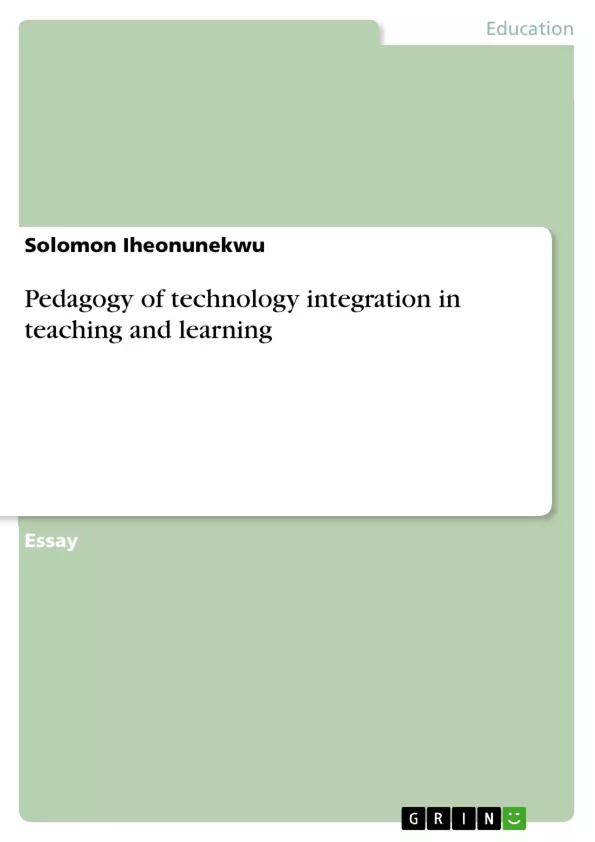This paper titled “pedagogy of technology integration in teaching and learning” examined the scope of technology integration in teaching and learning with a view of showing its relationship with pedagogy and also examined the problem of integrating technology into teaching and learning process. Common excuses for the limited use of technology to support instruction include shortage of computers, lack of computer skill and computer intimidation. While these could affect the success of technology integration, it should be acknowledged that the degree of success teachers have in using technology for instruction could depend in part on their ability to explore the relationship between pedagogy and technology. This paper shows that technology integration is narrowly perceived and that such a perception might hinder teachers’ understanding of the scope of technology in education. Technology integration should be considered along with issues involved in teaching and learning. Such issues include developing learning objectives, selecting methods of instruction, feedback, and evaluation and assessment strategies including follow-up activities. The paper concluded that it is important that educators perceive technology in education as part of the pedagogical process and also recognizes the relationship between pedagogy and technology in education. The following recommendations among others were made; Designing a dynamic classroom using technology requires teachers to provide a learning environment that is colorful, engaging, exciting, interactive and energetic as a way of encouraging students to venture into the world of technology and to discover knowledge for themselves; educators are encouraged to view technology integration from a wider perspective and be reflective in their teaching as they use technology to support and facilitate instruction and that instructional technology should be identified at the planning stage just as the students’ readiness is assessed, lesson objectives identified, methods of presenting are established, and evaluation strategies are determined.
Table of Contents
- Introduction
- The Scope of Instructional Technology
- Problems of Technology Integration
- Conclusion
Objectives and Key Themes
This paper examines the scope of technology integration in teaching and learning, highlighting its relationship with pedagogy and addressing the challenges of integrating technology into the instructional process. It aims to encourage teachers to view technology as an integral part of pedagogy and to recognize the importance of a comprehensive approach to technology integration.
- The relationship between technology integration and pedagogical principles.
- The impact of narrow perceptions of technology integration on teaching and learning.
- The importance of considering technology integration as part of the overall instructional design process.
- The role of teacher training and professional development in fostering effective technology integration.
- The need to address organizational, administrative, and pedagogical constraints that hinder technology integration.
Chapter Summaries
- Introduction: This chapter introduces the concept of technology integration in teaching and learning and highlights the importance of understanding the relationship between technology and pedagogy. It discusses the common misconception of technology as an add-on to instruction, emphasizing the need for a more integrated approach.
- The Scope of Instructional Technology: This chapter defines technology in education and examines its scope, emphasizing that it involves more than just the use of specific hardware and software. The chapter underscores the need for teachers to consider pedagogical principles when integrating technology, taking into account learning objectives, teaching methods, assessment strategies, and follow-up activities.
- Problems of Technology Integration: This chapter explores the challenges faced by teachers in effectively integrating technology into their teaching practices. It highlights the need for a comprehensive understanding of technology integration, addressing organizational, administrative, pedagogical, and personal constraints that may hinder its implementation. The chapter emphasizes the importance of teacher training and professional development in fostering effective technology integration.
Keywords
The main keywords and focus topics of this paper include pedagogy, technology, integration, teaching, learning, instructional design, teacher training, and professional development. These terms highlight the importance of understanding the relationship between pedagogy and technology and the need for a comprehensive approach to integrating technology into the teaching and learning process.
- Quote paper
- Solomon Iheonunekwu (Author), 2019, Pedagogy of technology integration in teaching and learning, Munich, GRIN Verlag, https://www.grin.com/document/515161



